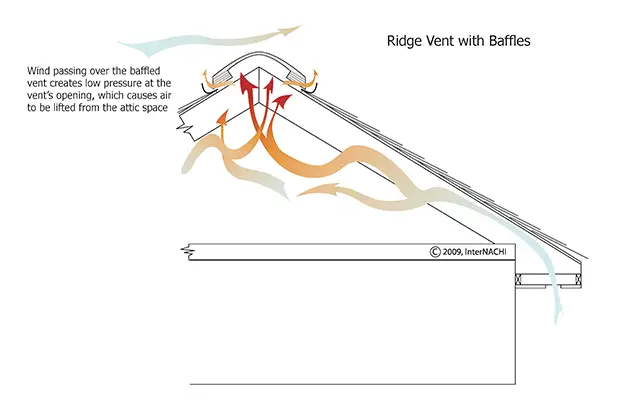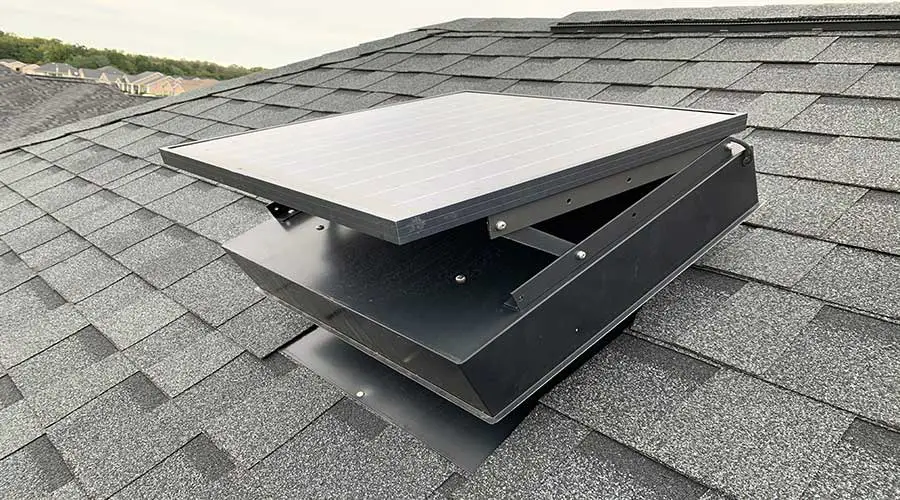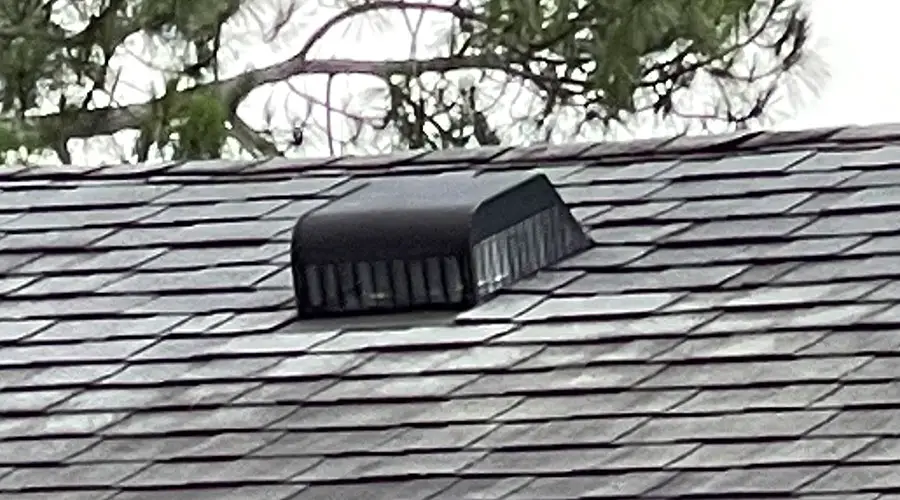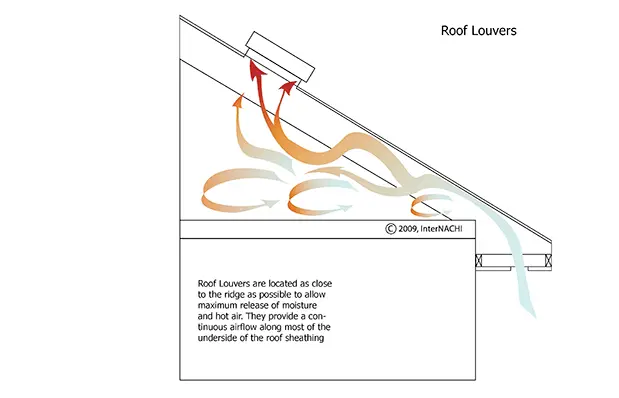
Roof venting uses air pressure to remove heat from the attic, which keeps your home comfortable. An attic not venting well can cause condensation, damage the roof structure, cause mold to form in the attic, and eventually spread throughout the house.
The best roof venting is a combination of soffit vents and ridge venting. These two work together by drawing in cooler air from the soffits, which push hot air out the ridge vent from the attic. You will need both venting types for adequate attic ventilation.
If you have a very hot attic during the summer or have a moldy or musty smell, installing a ridge vent may be the answer to creating a comfortable, fresh living area. Selecting the correct ridge vent for your home is essential, and once installed, you will notice an immediate difference in the comfort inside your home.
Ridge Vents
Ridge vents are popular for shingle roof houses, but options are available for all roofing types. You install ridge vents on the roof ridge where the two slopes meet.

Ridge vents fit along the entire length of the roof ridge, which means you’ll have a vent in the length of the roof. The ridge vent uses a small gap on both sides of the ridge to allow heat to escape.
The ridge vent fits over the space left between the two sides of the roof. The ridge vents are hardly noticeable in terms of aesthetic appeal and look like part of the roof. The vents are clad with the same material as the roof and thus blend perfectly into the roof design.
Ridge vents allow the free flow of hot, moist, and stale air out of the attic area while ensuring the roof’s integrity by keeping rainwater, debris, rodents, etc., out of the attic area.
Ridge vents are highly efficient as they don’t only have one exhaust vent. The vent runs along the entire length of the roof ridge, thus ensuring no dead spots in terms of expelling unwanted air.
Ridge vents are exhaust vents and therefore need to be installed together with inlet vents to ensure you can optimally utilize the ridge vents’ design features.
Why Install A Ridge Vent?
The main reasons that ridge vents are the best include:
- To ensure that the hot air trapped in the attic has the means to escape.
- Air in enclosed areas heats up during sunny days, which causes adjacent rooms to heat up. The unit will need to work harder to cool the house down if you’re using an air conditioner. Vents allow the hot air to escape, lowering the ambient temperature and saving you money on air conditioning.
- Roofing structures are usually manufactured from wood. Excessive moisture in enclosed areas such as attics causes the wood to absorb the moisture, promoting dampness and mold and ultimately rotting the wood, which leads to expensive repair costs. Roofing vents are designed to keep the enclosed area cool and dry. Adequate ventilation in the attic will ensure you achieve the longest possible lifespan from the roofing material.
Inlet And Exhaust Vents, What Are They?
An inlet vent is a general term for any vent installed in your attic or roof area that allows air to enter these areas. The exhaust vent is any vent that allows the hot, moist, or stale air to escape.
You must install the Inlet and exhaust vents in an attic to ensure a free flow of air into the space and back out. The inlet vent is installed as low as possible on the roof or attic area, while the exhaust vent is installed as high as possible. Installing them at different heights allows the hot air to rise and exit the exhaust vent while allowing fresh air to flow into the inlet vent.
Soffit Vents
A soffit vent sits in the soffit area on the underside of the roof. The soffit is the board that extends from the fascia board to the house wall, covering the bottom of the roof’s overhang.

Soffit vents are available in many designs, but all allow the free flow of air through their grid or slot patterned panel. Soffit vents are inlet vent that allows fresh air to flow into the roof.
Soffit vents are available in various shapes and materials such as plastic, aluminum, or steel. Choosing the right one for your home will depend on the soffit area’s design and the required flow.
Soffit vents always work in conjunction with ridge vents or similar exhaust vents, allowing fresh air into the roof through the soffit vent and expelling stale and hot air out of the exhaust vents through the convection principle. For the ventilation process to work effectively, you must fit an inlet and exhaust vent to the roof.
In older homes, soffit vents are rectangular holes covered with screening placed about eight feet apart in the soffit. In newer homes, the soffit vent is a continuous opening in the soffit covered with perforated vinyl.
Solar Powered Attic Vents
Solar-powered attic vents, or solar attic fans, as they’re also known, have become very popular for domestic applications in recent years. They work the same as an extractor fan or powered vent but use built-in solar panel energy.

The solar roof vent falls into the exhaust vent category and is thus mounted as high as possible on the roof. Solar-powered vents are reliant on the sun to work effectively.
Solar-powered attic fans are a great alternative to traditional hard-wired power attic vents. The power used to drive the fan’s motor is derived from the sun, ensuring ongoing free energy and ventilation, apart from the initial purchase cost.
Solar-powered attic vents generally don’t deliver the same extraction volume as hard-wired power attic vents due to the limited solar panel and motor size. It may thus be necessary to install multiple units to meet the required extraction volume.
Solar-powered attic fans get power from sunlight, so they are only suited to areas where sunshine is abundant. In areas where weather conditions aren’t favorable to solar throughout the year, Solar-powered you may use attic fans with other vent options.
The Remington Solar Attic Fan is our top pick for those that need a solar roof vent that can run day and night. It features a powerful brushless 30-watt motor for quiet operation. It's powered by the sun, so it runs free of electricity costs but has hybrid 110v power to run at night if needed.
The tiltable solar panel allows you to capture more southern sunlight for maximum effectiveness. Not all solar vents offer this feature.
It has a thermostat and humidistat to keep your attic at the perfect temperature and humidity. It's also hail and weather resistant, so you can rest assured that it will stand up to any condition.
Features a 30-day money-back guarantee, a 15-year warranty on the fan, and a 2-year warranty on the 110v adapter.
The 4 Seasons solar roof vent is perfect for keeping your home cool and comfortable all summer. The fan vents up to 400 CFM and cools up to 500 sq feet of attic space. The 10W monocrystalline solar panel provides plenty of power to keep your space cool, and the durable, weatherproof design ensures that it will last for years.
Installation is easy, and the quiet operation means you won't even know it's there. Plus, it comes with a 10-year limited warranty on materials and craftsmanship. Our main drawbacks are that it needs direct sunlight so effectiveness can be reduced in overcast conditions and is not designed for night use.
However, it's a great product and works well in areas that receive lots of direct sunlight.
Hard Wired Powered Attic Vents
Powered attic vents are powered by a motor-powered fan and controlled by a switch or preferably a humidistat. The fans can circulate the air in the attic or similar confined space or move hot out of the area through a roof vent.
Powered attic vents are well suited to applications where you must expel high volumes of air. The powered vents are used extensively in factory or warehouse environments, often in conjunction with ridge vents.
The downside of this system is that the fan-created noise may cause discomfort in some applications and, secondly, being hard-wired to the electrical supply costs money to run.
Various designs of power attic vents are available for commercial and domestic use. Selecting which will suit your particular application may require advice from a professional.
A hard-wired powered attic vent is essentially just an exhaust vent. They require ample inlet vents to prevent a negative pressure buildup in the attic.
Powered attic vents often have a louver-type grid or downward-facing exhaust pipe that expels attic air from the roof and, simultaneously, ensures that the opening in the roof remains weatherproof.
Box Vents
Box vents are the most common type of vets in use today. Their design is straightforward, cost-effective, easy to install, and has no moving parts that require periodic attention. They consist of a box-shaped cover covering the vent holes made in the roof.

Box vents contain ventilation holes, big enough to allow the free flow of air out of the roof but designed so that debris, water, and unwanted visitors can’t enter the roof.
The box vent covers a hole cut in the roof decking. One vent for every 300 square feet of attic space for insulated roofs is required. The guideline becomes one vent for every hundred and fifty square feet of attic space for uninsulated roofs.
Box vents are mounted as high up on the roof as possible, just below the roof’s ridge, to take advantage of the hot air rising principle. Box vents work with soffit vents to ensure the free flow of air through the roof.
Domestic box vents are relatively small. They can be clad with the appropriate roofing material or painted to blend in with the roof color.
Box vents are exhaust vents and therefore require adequately sized inlet vents to be installed in the critical area to ensure adequate airflow.
Off Ridge Vents
Off ridge vents are very similar in design to box vents. As the name implies, they’re installed just under the roof ridge but still high enough to expel the hot and often moist air buildup in your roof or attic.

The design of the off ridge vent is such that optimum airflow is maintained while keeping out rain, wind, debris, and unwanted critters. Most off ridge vents have a filter system that needs attention from time to time. Wasp nests, for instance, have been known to be built in the vent openings, which can reduce the efficiency of the vent or even block it completely.
Off Ridge vents are used mainly in industrial applications on metal roofs. Many designs are available for domestic use, so shop around and request professional advice to ensure you buy the correct vent for your requirements.
Off ridge vents are exhaust vents and must be used in conjunction with an inlet vent such as a soffit vent to ensure optimal airflow through the target area.
Roof Turbines
Roof turbines are common in industrial buildings such as factories. Generally, their roofs are often steel sheeting which heats up significantly in the sun.
Roof turbines, aka chimney turbines, consist of a base plate attached to a tube, onto which the vented ball-shaped turbine fits. The turbine spins as the hot air flow expels through the turbine.
Roof turbines spin as a result of wind that catches the blades on the turbine. This movement then creates a nimbus of low pressure in the center of the turbine. The low-pressure point, combined with the natural tendency of hot air to rise, draws the hot air up and out through the turbine vent.
Conclusion
Adequate ventilation in your home’s attic area is something we don’t think about often. Good ventilation will cool down your home in summer by reducing the heat buildup in the roof space. In turn, it cools down your living areas.
More importantly, good ventilation extends the life of your roofing material. Excessive moisture buildup in the attic creates an uncomfortable environment that may lead to humidity and mold that promotes the rotting of the wood used in the roof structure.
Excessive moisture buildup in cool weather can lead to ice forming in the attic area, which, when it melts, will run down your wall and cause massive damage. All of this can be prevented by having sufficient ventilation installed.









